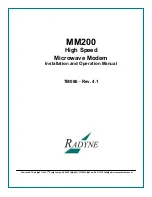
15
CHAPTER 2: Introduction
Other uses include direct links to colleagues with modems, to banks, and to service
bureaus. You can also telecommute with your fax modem—work at home while
communicating with the office by modem or fax.
And of course, you can use your modem to exchange faxes with any fax machine in
the world, enabling you to communicate quickly with businesses and organizations
that do not have direct modem communications.
2.5 Features
• Complies with major ITU-T, TIA, and EIA international standards to ensure
compatibility with other modems.
• Caller ID capability can identify a caller’s phone number (available only on
U.S. products).
2.5.1 D
ATA
• Supports the V.90 standard for data transmission speeds up to 56 kbps while
maintaining compatibility with lower-speed modems.
• Supports the enhanced ITU-T V.34 standard, with data transmission speeds to
33.6 kbps.
• Supports asynchronous data rates at 56, 33.6, 31.2, 28.8, 26.4, 24, 21.6, 19.2,
16.8, 14.4, and 12 kbps as well as 9600, 4800, 2400, 1200, and 300 bps.
• Supports automatic fallback to slower speeds in noisy line conditions, and fall-
forward to faster speeds as conditions improve.
• ITU-T V.42 LAP-M and MNP Class 3 and 4 error correction.
• ITU-T V.42bis (4-to-1) and MNP 5 (2-to-1) data compression.
• Automatically disables data compression when transferring already-
compressed files.
• Autodial, redial, pulse (rotary), and touch-tone dial.
• Dial tone and busy signal detection for reliable call-progress reporting.
• Compatible with the standard AT command set used by most communication
programs.















































